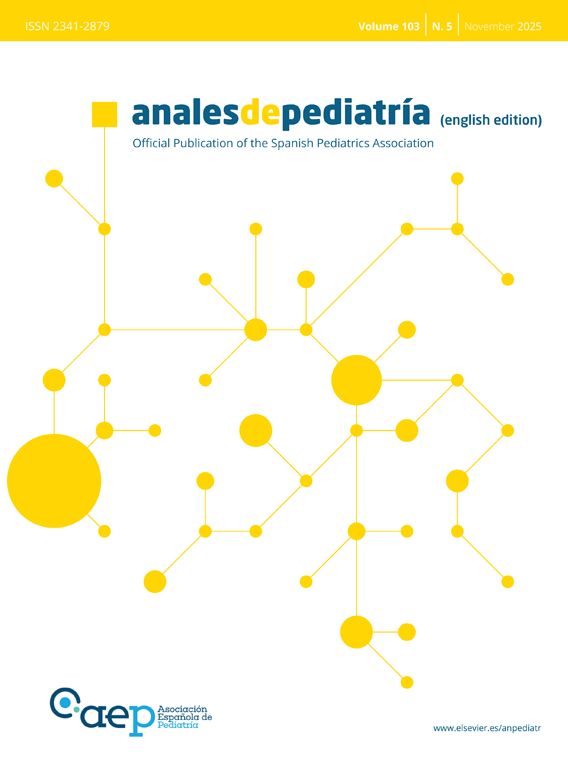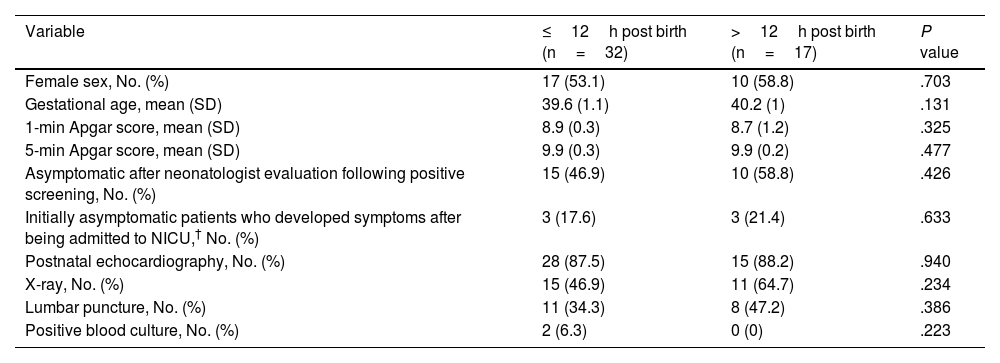Critical congenital heart defects (CCHDs) are life-threatening and require prompt intervention. Although screening is recommended,1 it mainly detects noncardiac conditions.2 The timing of screening is controversial because early diagnosis of CCHDs improves health outcomes,3 but screening within 12h from birth may increase the false positive rate.
We conducted a retrospective study in a level III neonatal intensive care unit (NICU) where some medical staff perform targeted neonatal echocardiography. There are fetal echocardiography and pediatric cardiology consultants on site on weekday mornings, but there are nither cardiac surgery nor cardiac catheterization.
We included all newborns with a positive CCHD screening within 48h from birth between March 1, 2019 and April 30, 2023. We excluded newborns considered symptomatic by the nurse prior to screening. The primary outcome was the occurrence of a ‘relevant outcome’, a composite of: transfer to another hospital, delivery of noninvasive ventilation (NIV) for more than two hours, intubation, antibiotherapy lasting more than 48h and death. We established the cutoff for group comparisons at 12h post birth.
Nonnormally distributed data were compared by means of the Mann-Whitney U test and normally distributed data with the t test for independent samples. Categorical data were compared with χ2 test. We defined significance as a P value of less than 0.05. The study was approved by the ethics committee of the hospital.
Of the 6976 infants born during the study period, 49 (0.7%) were admitted to the NICU due to a positive CCHD screening, and 32 (65.3%) of them were admitted within 12h from birth. Table 1 presents the characteristics of the patients and the diagnostic tests performed, Fig. 1 shows the distribution of diagnoses according to the timing of screening.
Baseline characteristics of the patients and performed diagnostic tests.
| Variable | ≤12h post birth (n=32) | >12h post birth (n=17) | P value |
|---|---|---|---|
| Female sex, No. (%) | 17 (53.1) | 10 (58.8) | .703 |
| Gestational age, mean (SD) | 39.6 (1.1) | 40.2 (1) | .131 |
| 1-min Apgar score, mean (SD) | 8.9 (0.3) | 8.7 (1.2) | .325 |
| 5-min Apgar score, mean (SD) | 9.9 (0.3) | 9.9 (0.2) | .477 |
| Asymptomatic after neonatologist evaluation following positive screening, No. (%) | 15 (46.9) | 10 (58.8) | .426 |
| Initially asymptomatic patients who developed symptoms after being admitted to NICU,† No. (%) | 3 (17.6) | 3 (21.4) | .633 |
| Postnatal echocardiography, No. (%) | 28 (87.5) | 15 (88.2) | .940 |
| X-ray, No. (%) | 15 (46.9) | 11 (64.7) | .234 |
| Lumbar puncture, No. (%) | 11 (34.3) | 8 (47.2) | .386 |
| Positive blood culture, No. (%) | 2 (6.3) | 0 (0) | .223 |
Abbreviations: SD, standard deviation; NICU, neonatal intensive care unit.
There were no significant differences in the frequency of ‘relevant outcomes’ between the groups (≤12h group, 20 [62.5%] vs>12h group, 14 [82.4%]; P=.151). We also found no differences when we analyzed the outcomes independently: NIV (≤12h group, 19 [59.4%] vs >12h group, 13 [76.5%]; P=.231), one patient intubated in the group screened within 12h, antibiotherapy longer than 48h (13 [40.6%] vs 9 [52.9%]; P=.272). Two patients (4.1%) were transferred: one for ECMO due to persistent pulmonary hypertension of the newborn (PPHN), and another due to suspected interruption of the aortic arch, which was later ruled out; both were screened within 12h from birth. None of the patients died.
Prompt detection of CCHD allows timely treatment, but the false positive rate is greater when screening is performed before 12h post birth, which results in unnecessary testing.3 Singh et al. found a reduction in early infant death within 24h of birth of 30.7% due to diagnosed CCHD, but screening at 24h post birth could not prevent deaths in the first 24h.2 Liberman et al. did not find a reduction in delayed diagnosis of CCHD over time after implementation of pulse oximetry screening.4
Defining what constitutes a false positive in CCHD screening is complicated, since most positive screenings detect other issues such as sepsis or PPHN2 that require admission and treatment. This, along with the low cost and non-invasive nature of screening, suggests broader benefits beyond CCHD detection. However, the inherent risks of performed tests (such as exposure to radiation, antibiotics or complications of the techniques) and separating the infant from the parents must be recognized. Lastly, the increase in the prenatal diagnosis of CCHD may change the pre-test probability and therefore affect the performance of screening.4,5 A change in nomenclature to “hypoxemia screening” might be more accurate and would better reflect its actual usefulness.
Regardless of the purpose of screening, setting the best timing is controversial. Despite the lack of statistical significance in our cohort, five of the six patients with transitional circulation underwent screening within 12h from birth, while the two patients with a positive blood culture and the two who were transferred were symptomatic at the time of evaluation by the neonatologist, so they would have probably been admitted anyway. Moreover, in the group screened after 12h, there was a higher frequency of ‘relevant outcomes’, with more frequent need of NIV and performance of diagnostic tests. Although these differences were not statistically significant, they suggest a trend that could become more evident with a larger sample size or in specific contexts. This trend is consistent with the observed increase in false positive results from early screening.2 Thus, we consider that early physical examination within 12 to 18h post birth and deferring screening to 12h post birth could be a safe strategy to prevent unnecessary admissions without misdiagnosing relevant conditions. However, future studies with greater statistical power are required to further explore these observations in depth.
When it comes to the limitations of the study, the availability of fetal echocardiography may have reduced the yield of screening, as most CCHDs could have been diagnosed prenatally. In addition, the lack of statistical significance may have been due to the small sample size.
As for the study strengths, CCHD screening was performed systematically and a postnatal echocardiography was performed in most admitted patients, so it is unlikely that any of the CCHDs were misdiagnosed.
In conclusion, we found no significant differences in patient outcomes based on the timing of CCHD screening. Although transitional circulation was more common in infants screened within 12h post birth, so were other relevant noncardiac conditions. Further research is required to establish the optimal timing of screening.
Meeting presentation: This study was presented at the annual meeting of the Sociedad Española de Neonatología; October 2023; Santiago de Compostela, Spain; and at the meeting of the Sociedad de Pediatría de Asturias, Cantabria y Castilla y León; 2023; Valladolid, Spain.






